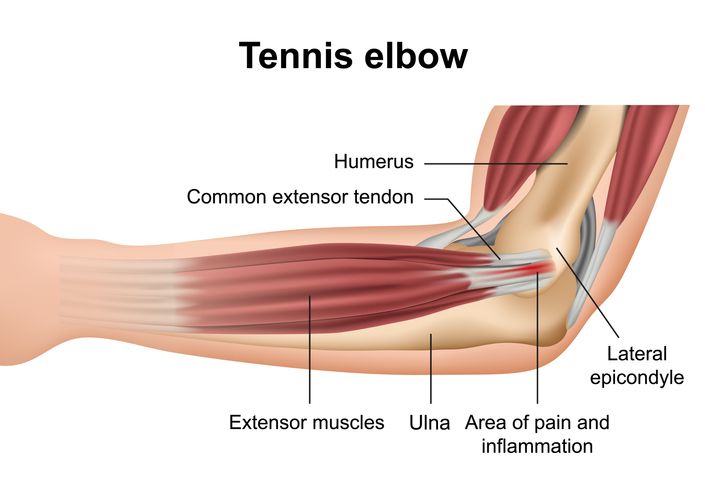Tennis elbow

What is tennis elbow?
Tennis elbow is the inflammation of the tendon attachment at the lateral epicondyle of the humerus. It is also referred to as lateral epicondylitis ('itis' means inflammation in latin). The area where pain is felt is show in the diagram above.
A less common pain, which can get confused for tennis elbow but isn't, is inflammation of the radial nerve. The reason for this is the radial nerve runs close to the lateral epicondyle, but its symptoms are slightly different. These can include general muscular weakness in the forearm, pain or aching all the time (not just when gripping) and loss of sensation / tingling. Another common grip related issue that people can confuse for tennis elbow is golfer's elbow. This is inflammation of the tendon on the medial epicondyle and is discussed in another article here.
What causes tennis elbow?
Tennis elbow is a 'chronic' grip related condition, whereby the forearm extensors are overworked over a long period of time; which in turn causes extra stress at the tendinous attachment. However, it is worth noting that tennis elbow can also be influenced by poor mobility / stiffness in the neck and shoulders, as well as impingment of the radial nerve.
What can I do day-to-day to improve it?
If you have pain, but do not feel it is due to 'overuse' (i.e. your not using your hand to grip things all the time) please speak to a doctor first. If you are an active person, who plays a grip related sport (such as tennis, squash, golf) have a chat with your coach. Often a change of racket size, beam length, or grip size can all help to reduce your symptoms. For sufferers where it is happening as part of your job, talk to your employer, there maybe adaptations (to your job) that can be made to reduce the stress on your body.
Suitable therapies
For all people hands-on work such as Sports Massage can be supportive, as well as other therapies such as acupuncture. For chronic conditions, self help techinques are important to help manage the symptoms day-to-day. These will be shown to you by your practitioner. It's important to note that if you wish to make a permanent change to your pain, it is important to reduce the load on the muscles, so changing the way you do things, or looking at your technique (as discussed in the paragraph above) is also key.
